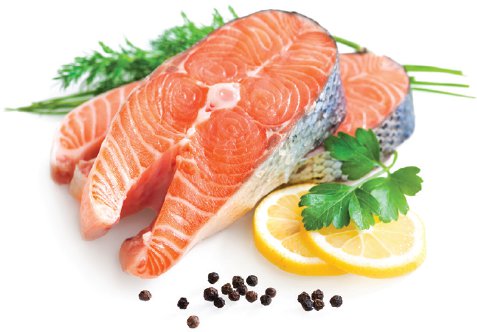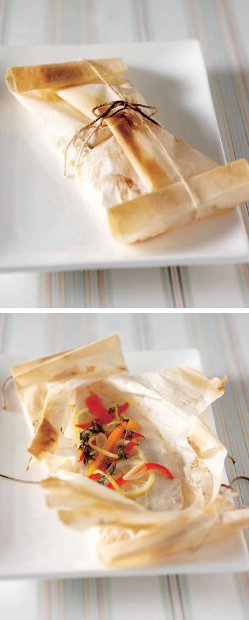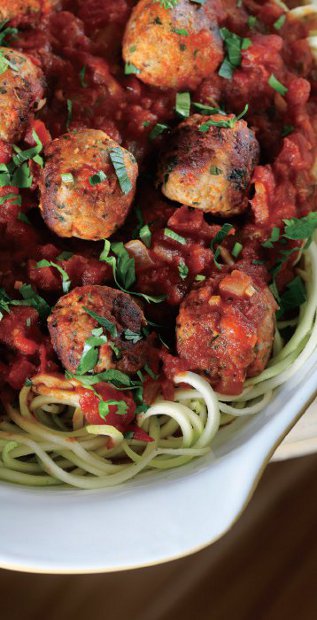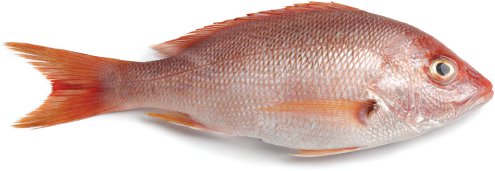SEAFOOD
Seafood is the most digestible of proteins and a great option for anyone trying to transition away from animal proteins. Seafood dishes do best when simply prepared with herbs and lemon, but when I am trying to recruit mainstream meat eaters, I will go the extra mile and make tuna meatballs or salmon burgers. Inevitably, they will be sold and requested again.
When selecting fish, choose wild or organically fed. Bottom-dwellers such as shellfish carry a higher toxic load and are best avoided or enjoyed only on occasion.
Everyone seems to have a different reaction to seafood. Vegetarians, raw foodies, and vegans shun it; environmentalists are concerned (quite rightly) about overfishing and contaminating our oceans; and others simply dislike seafood. But for most of us, it is a favorite menu option. I share all the same concerns about overfishing and the decline of our underwater ecosystems. I also take into full consideration the heavy metals and other toxins that are becoming part and parcel of the biomass of fish. However, as we seek creative ways to balance the physical, social, and emotional needs of detox dieters as they transition away from the modern diet to a more enlightened one, seafood provides a footbridge over treacherous waters. It is one of the few food groups that will satiate you without compromising digestibility or derailing your weight loss and cleansing efforts. So if you love seafood and are mindful of where you get it from, there is a place for it in your detox diet. Now, please pass the Ginger Miso Glazed Salmon!
—NATALIA

Fish with Julienned Vegetables in Parchment
Using parchment paper is a great way to keep foods from sticking to the pan in the oven without using oil. Cooking in parchment packets seals in flavors and allows a dish to steam, creating its own juices.
2 (6-ounce) skinless red snapper fillets
Sea salt and pepper
½ bunch asparagus, trimmed and sliced diagonally in half
1 small zucchini, julienned
½ red, orange, or yellow bell pepper, cored and julienned
1 tablespoon thyme leaves
1 tablespoon chopped parsley
1 lemon, thinly sliced
1 tablespoon extra-virgin olive oil
Preheat the oven to 400°F. Season the fillets on each side with salt and pepper. Cut out two 1½-foot pieces of parchment paper. Place a fillet lengthwise on each piece of parchment and add the vegetables, herbs, and sliced lemons. Drizzle oil over all. To seal the parchment packets, bring the opposite ends together and fold several times to close. Fold in the edges and wrap with butcher twine like a present. Bake for 15 minutes or more, depending on the thickness of the fish (about 10 minutes per inch).
SERVES 2

Steamed Sea Bass with Ginger and Scallions
2 (6-ounce) skinless sea bass fillets or other firm white fish
Salt and pepper
1 knob ginger, peeled and cut into matchsticks
2 garlic cloves, thinly sliced
2 tablespoons nama shoyu
1 teaspoon toasted sesame oil
2 scallions, julienned
½ red bell pepper, cored and julienned
2 red chile peppers, sliced thin
Set a large bamboo or metal steamer basket over a skillet of simmering water over medium heat.
Place the fish on a plate and season with salt and pepper. Arrange the ginger and garlic on top of the fish in an even layer. Mix the nama shoyu with the sesame oil and pour over the fish. Top with the scallions, red pepper, and chile peppers.
Place the plate in the steamer and cover. Steam the fish until just cooked through (8−10 minutes, depending on the thickness). Carefully remove the hot plate from the basket and serve.
SERVES 2
Ginger Miso Glazed Salmon
1 tablespoon white miso paste
2 tablespoons mirin
2 tablespoons soy sauce
1 knob ginger, grated
1 tablespoon sesame oil
1 tablespoon agave nectar or 3-4 drops liquid stevia
2 (6-7 ounce) salmon fillets
Preheat the oven to 400°F. In a large bowl whisk together the marinade ingredients. Add the salmon fillets and coat thoroughly. Let sit for a few minutes to marinate. Transfer to a parchment-lined baking sheet. Bake for 10 minutes or more, depending on the thickness of the fillets.
SERVES 2
Whole Roasted Fish with Fennel
Have your local fishmonger clean the fish for you: scales, guts, and fins removed.
1 (1½-2 pound) cleaned whole fish (rainbow trout, sea bass or branzino, or Arctic char)
Sea salt and pepper
1 lemon, sliced
1 fennel bulb, thinly sliced, fennel fronds reserved
3 garlic cloves, minced
5 thyme sprigs
2 fresh bay leaves
Preheat the oven to 400°F. Place the fish on a parchment-lined baking tray. Season with salt and pepper on both sides. Line the cavity of the fish with lemon slices and the rest of the ingredients. Use twine if necessary to keep the filling from spilling out. Bake for 30 minutes or more, depending on the thickness of the fish (about 10 minutes per inch).
SERVES 2
Tuna Meatballs
Tuna meatballs, which are made without bread crumbs or eggs, are a great alternative to traditional beef meatballs. These are perfect for converting big meat eaters to lighter, healthier dinners. Serve with any of the tomato sauces in the Basic Recipes section (see page 91) with zucchini pasta or steamed spaghetti squash.
1 pound fresh tuna, chopped into 1-inch pieces
2 ounces sheep pecorino cheese, grated (optional)
2 garlic cloves, minced
Handful of parsley, minced
1 teaspoon dried oregano
1 lemon, zest and juice
Sea salt and pepper
1 tablespoon extra-virgin olive oil
Preheat the oven to 400°F. Place all the ingredients in a food processor and pulse until just combined. Form the resulting mixture into 6 to 8 balls, depending on the desired size. Transfer to a parchment-lined baking tray and bake for about 8 minutes, shaking the pan occasionally to brown the meatballs evenly on all sides.
MAKES 6–8 TUNA MEATBALLS

Cod Poached in Tomato Sauce with Fresh Basil
2 cups Basic Tomato Sauce (see page 93)
½ cup water
2 (6-ounce) cod fillets
Handful of fresh chopped basil
1 lemon, halved
In a medium-size saucepan, heat the tomato sauce and water and bring to a simmer. Add the fillets and cover. Lower the heat and cook until the fish is opaque and cooked through (about 8−10 minutes). Garnish with the fresh basil and squeeze on the lemon juice.
SERVES 2
Fish Taco Wraps
FOR THE MARINADE:
3 garlic cloves
1 bunch cilantro, chopped
2 limes, zest and juice
1 teaspoon cumin
1 teaspoon ancho chile powder
Salt and pepper to taste
FOR THE FISH TACO WRAPS:
2 (10–12 ounce) red snapper fillets
1 bunch red leaf lettuce, whole leaves for wraps
2 cups finely shredded red or white cabbage
1 cup Creamy Chipotle Sauce (see page 105)
2 cups Pico de Gallo (see page 102)
Preheat the oven to 400°F. In a large bowl, whisk together the marinade ingredients. Add the fish and coat thoroughly. Let marinate for 20 minutes or more.
Transfer the fish to a parchment-lined baking sheet. Bake for 10 minutes or more, depending on the thickness of the fillet (about 10 minutes per inch).
To assemble each taco, place a forkful of the fish on a lettuce leaf with some cabbage, add a drizzle of chipotle sauce, and top with Pico de Gallo. Serve with the rest of the sauces on the side.
SERVES 4

Salmon Burgers
This recipe can be used to create salmon burgers or salmon cakes, a great alternative to crab cakes.
1 pound fresh salmon, skin removed
1 tablespoon Dijon mustard
2 tablespoons minced red onions
2 garlic cloves, minced
1 tablespoon capers, rinsed and drained
1 tablespoon finely chopped parsley
1 teaspoon finely chopped dill or tarragon, optional
Sea salt and pepper to taste
Preheat the oven to 400°F. Place all the ingredients in a food processor and pulse until just combined. Form the resulting mixture into 3 patties or 6 salmon cakes. Transfer to a parchment-lined baking tray and bake for 8 to 10 minutes, flipping once.
MAKES 3 BURGER PATTIES OR 6 SALMON CAKES
Salmon Fish Pie with Cauliflower Puree Topping
When I make this for clients, they often ask me if it’s really okay to eat something so decadent when they’re supposed to be detoxing. I love to reassure them that, yes, it’s really okay.
12 ounces salmon fillet, skin removed
Salt and pepper
1 fennel bulb, thinly sliced
1 small onion, thinly sliced
1 teaspoon thyme leaves
Juice of 1 small orange
Basic Cauliflower Puree (see page 188)
1 pat of butter (optional)
Preheat the oven to 400°F. Season the salmon with salt and pepper and transfer to a parchment-lined baking tray. Toss the fennel, onion, thyme, and juice together on a separate parchment-lined baking tray. Bake both trays for about 10 minutes until the fish is cooked through and opaque.
Break the salmon into large pieces and place in a loaf pan. Top with a layer of the fennel and onion mixture. Top with the cauliflower puree, and add a pat of butter if desired. Bake for an additional 10 minutes.
SERVES 2